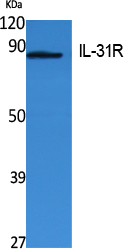IL-31Rα Polyclonal Antibody
- Catalog No.:YT5091
- Applications:WB;ELISA
- Reactivity:Human;Mouse
- Target:
- IL-31Rα
- Fields:
- >>Cytokine-cytokine receptor interaction
- Gene Name:
- IL31RA
- Protein Name:
- Interleukin-31 receptor subunit alpha
- Human Gene Id:
- 133396
- Human Swiss Prot No:
- Q8NI17
- Mouse Swiss Prot No:
- Q8K5B1
- Immunogen:
- Synthesized peptide derived from the Internal region of human IL-31Rα.
- Specificity:
- IL-31Rα Polyclonal Antibody detects endogenous levels of IL-31Rα protein.
- Formulation:
- Liquid in PBS containing 50% glycerol, 0.5% BSA and 0.02% sodium azide.
- Source:
- Polyclonal, Rabbit,IgG
- Dilution:
- WB 1:500 - 1:2000. ELISA: 1:40000. Not yet tested in other applications.
- Purification:
- The antibody was affinity-purified from rabbit antiserum by affinity-chromatography using epitope-specific immunogen.
- Concentration:
- 1 mg/ml
- Storage Stability:
- -15°C to -25°C/1 year(Do not lower than -25°C)
- Other Name:
- IL31RA;CRL3;GPL;Interleukin-31 receptor subunit alpha;IL-31 receptor subunit alpha;IL-31R subunit alpha;IL-31R-alpha;IL-31RA;Cytokine receptor-like 3;GLM-R;hGLM-R;Gp130-like monocyte receptor;Gp130-like receptor;ZcytoR17
- Observed Band(KD):
- 82kD
- Background:
- The protein encoded by this gene belongs to the type I cytokine receptor family. This receptor, with homology to gp130, is expressed on monocytes, and is involved in IL-31 signaling via activation of STAT-3 and STAT-5. It functions either as a monomer, or as part of a receptor complex with oncostatin M receptor (OSMR). Several alternatively spliced transcript variants encoding different isoforms have been noted for this gene.[provided by RefSeq, Jun 2011],
- Function:
- function:Associates with OSMR to form the interleukin-31 receptor which activates STAT3 and to a lower extent STAT1 and STAT5. May function in skin immunity.,induction:Up-regulated in lesional keratinocytes of patients with atopic dermatitis. Up-regulated by IFNG and lipopolysaccharides.,PTM:N-glycosylated.,similarity:Belongs to the type I cytokine receptor family. Type 2 subfamily.,similarity:Contains 5 fibronectin type-III domains.,subunit:Heterodimer with OSMR. Interacts with JAK1 and STAT3.,tissue specificity:Expressed at low levels in testis, ovary, brain, prostate, placenta, thymus, bone marrow, trachea and skin. Detected in all of the myelomonocytic lineage. Expressed in CD14-and CD56-positive blood cells and by macrophages (at protein level).,
- Subcellular Location:
- Cell membrane ; Single-pass type I membrane protein . Cell junction, synapse, presynaptic cell membrane . Cell projection, axon .
- Expression:
- Expressed in CD14- and CD56-positive blood cells (PubMed:11877449). Expressed in macrophages (PubMed:16461143, PubMed:18439099). Expressed in keratinocytes (PubMed:21261663). Expressed in a subset of dorsal root ganglia neurons (at protein level) (PubMed:24373353). Expressed at low levels in testis, ovary, brain, prostate, placenta, thymus, bone marrow, trachea and skin (PubMed:15184896, PubMed:11877449, PubMed:14504285). Expressed in bronchial and alveolar epithelial cells and pulmonary fibroblasts (PubMed:18439099). Detected in all of the myelomonocytic lineage (PubMed:14504285). Isoform 6: Expressed at higher levels in lesional skin compared to healthy skin of atopic dermatitis patients (PubMed:24373353).
Anti-atopic dermatitis effect of fraxinellone via inhibiting IL-31 in vivo and in vitro Heliyon Niuniu Yang WB Human 1:1000 HaCaT cell
- June 19-2018
- WESTERN IMMUNOBLOTTING PROTOCOL
- June 19-2018
- IMMUNOHISTOCHEMISTRY-PARAFFIN PROTOCOL
- June 19-2018
- IMMUNOFLUORESCENCE PROTOCOL
- September 08-2020
- FLOW-CYTOMEYRT-PROTOCOL
- May 20-2022
- Cell-Based ELISA│解您多样本WB检测之困扰
- July 13-2018
- CELL-BASED-ELISA-PROTOCOL-FOR-ACETYL-PROTEIN
- July 13-2018
- CELL-BASED-ELISA-PROTOCOL-FOR-PHOSPHO-PROTEIN
- July 13-2018
- Antibody-FAQs
- Products Images

- Western Blot analysis of extracts from Jurkat cells, using IL-31R Polyclonal Antibody. Secondary antibody(catalog#:RS0002) was diluted at 1:20000



